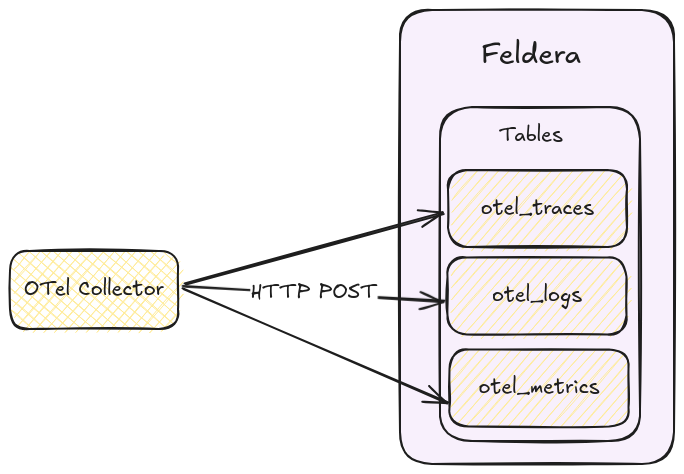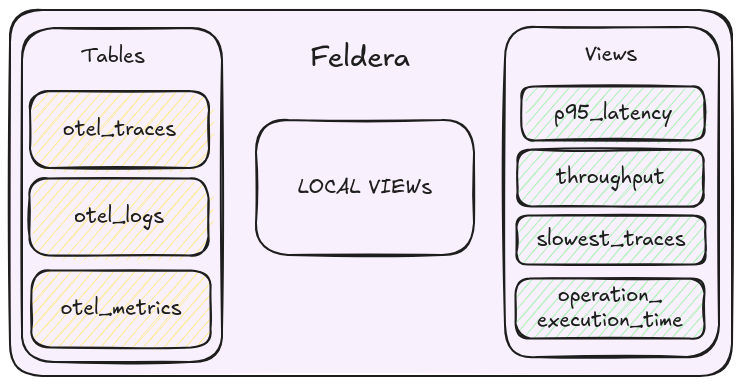Sending OTel data to Feldera
To push data into Feldera, we configure the OpenTelemetry (OTel) Collector to send data to Feldera via HTTP (see: HTTP Ingress Docs).
OTel Collector Configuration:
Here we configure OTel Collector to send logs, traces, and metrics to Feldera as JSON via an HTTP POST request without any compression.

Configure your OTel Collector as follows:
# src/otel-collector/otelcol-config-extras.yml in OpenTelemetry Demo
exporters:
# Send traces to the Feldera pipeline.
# Currently only uncompressed JSON is supported.
otlphttp/feldera:
logs_endpoint: http://feldera:8080/v0/pipelines/otel/ingress/otel_logs?format=json&update_format=raw
traces_endpoint: http://feldera:8080/v0/pipelines/otel/ingress/otel_traces?format=json&update_format=raw
metrics_endpoint: http://feldera:8080/v0/pipelines/otel/ingress/otel_metrics?format=json&update_format=raw
encoding: json
compression: none
service:
pipelines:
traces:
receivers: [otlp]
processors: [transform, batch]
exporters: [spanmetrics, otlphttp/feldera, debug, otlp]
logs:
receivers: [otlp]
processors: [batch]
exporters: [otlphttp/feldera, debug]
metrics:
receivers: [hostmetrics, docker_stats, httpcheck/frontend-proxy, otlp, prometheus, redis, spanmetrics]
processors: [batch]
exporters: [otlphttp/feldera, debug]
Notice that we have the query parameters (see: JSON Format Docs): format=json&update_format=raw
format=json: Specifies that the input data is JSON-formatted.update_format=raw: Indicates that the request body contains raw data, which Feldera processes as an insertion into the table.
Pre-processing

The OTel data format contains data in arrays of fields, we want to convert them into traditional database table rows, this would allow for easier processing in SQL.
We do this by performing a series of UNNEST operations.
Step 1: Extract Resource-Level Data
-- concat with the previous table definitions
-- (ResouceMetrics[N]) -> (Resource, ScopeMetrics[N])
CREATE LOCAL VIEW rsMetrics AS SELECT resource, scopeMetrics
FROM otel_metrics, UNNEST(resourceMetrics) as t (resource, scopeMetrics);
-- (ResouceSpans[N]) -> (Resource, ScopeSpans[N])
CREATE LOCAL VIEW rsSpans AS SELECT resource, scopeSpans
FROM otel_traces, UNNEST(resourceSpans) as t (resource, scopeSpans);
-- (ResouceLogs[N]) -> (Resource, ScopeLogs[N])
CREATE LOCAL VIEW rsLogs AS SELECT resource, scopeLogs
FROM otel_logs, UNNEST(resourceLogs) as t (resource, scopeLogs);
Here we UNNEST arrays of ResourceSpans, ResourceMetrics and ResourceLogs into separate rows.
Step 2: Extract Scope-Level Data
-- (ScopeMetrics[N]) -> (ScopeMetrics) x N
CREATE LOCAL VIEW metrics_array AS
SELECT
resource,
scope,
metrics
FROM rsMetrics, UNNEST(rsMetrics.scopeMetrics) as t(scope, metrics);
-- (ScopeLogs[N]) -> (ScopeLogs) x N
CREATE LOCAL VIEW logs_array AS
SELECT
resource,
scope,
logs
FROM rsLogs, UNNEST(rsLogs.scopeLogs) as t(scope, logs);
-- (ScopeSpans[N]) -> (ScopeSpans) x N
CREATE LOCAL VIEW spans_array AS
SELECT
resource,
scope,
spans
FROM rsSpans, UNNEST(rsSpans.scopeSpans) as t(scope, spans);
Similarly, we UNNEST the ScopeMetrics, ScopeLogs and ScopeSpans into separate rows.
Step 3: Extract Final Metrics and Logs
-- (Metrics[N]) -> (_, Metric) x N
CREATE MATERIALIZED VIEW metrics AS
SELECT
name,
description,
unit,
sum,
summary,
gauge,
histogram,
exponentialHistogram,
resource,
scope,
metadata
FROM metrics_array, UNNEST(metrics_array.metrics);
-- (Logs[N]) -> (_, Logs) x N
CREATE MATERIALIZED VIEW logs AS
SELECT
resource,
scope,
attributes,
timeUnixNano,
observedTimeUnixNano,
severityNumber,
severityText,
flags,
traceId,
spanId,
eventName,
body
FROM logs_array, UNNEST(logs_array.logs);
Finally, we have extracted individual Metric and LogRecords to extract individual records.
Step 4: Process Spans and Add Derived Fields
For spans, we not only extract individual records but also compute useful derived fields:
elapsedTimeMillis: The duration of the span in milliseconds.eventTime: Timestamp indicating when the span started1.
-- Convert nanoseconds to seconds
CREATE FUNCTION NANOS_TO_SECONDS(NANOS BIGINT) RETURNS BIGINT AS
(NANOS / 1000000000::BIGINT);
-- Convert nanoseconds to milliseconds
CREATE FUNCTION NANOS_TO_MILLIS(NANOS BIGINT) RETURNS BIGINT AS
(NANOS / 1000000::BIGINT);
-- Convert to TIMESTAMP type from a BIGINT that represents time in nanoseconds
CREATE FUNCTION MAKE_TIMESTAMP_FROM_NANOS(NANOS BIGINT) RETURNS TIMESTAMP AS
TIMESTAMPADD(SECOND, NANOS_TO_SECONDS(NANOS), DATE '1970-01-01');
-- (Spans[N]) -> (Span, elapsedTimeMillis, eventTime) x N
CREATE MATERIALIZED VIEW spans AS
SELECT
resource,
scope,
traceId,
spanId,
tracestate,
parentSpanId,
flags,
name,
kind,
startTimeUnixNano,
endTimeUnixNano,
attributes,
events,
NANOS_TO_MILLIS(endTimeUnixNano::BIGINT - startTimeUnixNano::BIGINT) as elapsedTimeMillis,
MAKE_TIMESTAMP_FROM_NANOS(startTimeUnixNano) as eventTime
FROM spans_array, UNNEST(spans_array.spans);
Footnotes
-
Note that in Feldera, the
TIMESTAMPtype doesn't include time zone information. ↩